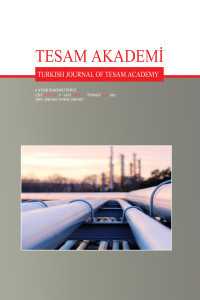Yemen’de Devam Etmekte Olan Çatışma: Bir Vekalet Savaşı mı?
Yemen, İç Savaş, Vekalet Savaşı, Suudi Arabistan, İran
ONGOING CONFLICT IN YEMEN: A PROXY WAR?
Yemen, Civil War, Proxy War, Saudi Arabia, Iran,
___
- Arimatsu L. and Choudhury, M. (March 2014). The legal classification of the armed conflicts in Syria, Yemen and Libya. Chatham House. Accessed: 10.03.2018, https://www.chathamhouse.org/sites/files/chathamhouse/home/chatham/public_html/sites/default/files/20140300ClassificationConflictsArimatsuChoudhury1.pdf, 1-43.
- Arraf, S. (October 2017). The armed conflict in Yemen: A complicated mosaic. The Geneva Academy. Accessed: 10.03.2018, https://www.geneva-academy.ch/joomlatools-files/docman-files/The%20Armed%20Conflict%20in%20Yemen.pdf, 1-10.
- Birchall, G. (April 12, 2018). What is a proxy war, what happened during the cold war and is there a proxy war in Syria between the US and Russia? The SUN, Accessed: 13.04.2018. https://www.thesun.co.uk/news/6039358/what-is-a-proxy-war-what-happened-during-the-cold-war-and-is-there-a-proxy-war-in-syria-between-the-us-and-russia/
- Broder, J. (December 2017). Hit and missile. Newsweek. 8-12.
- Calabresi, M. (April 2015). Caught in the cross fire. TIME, 25-27.
- Cockburn, Patrick (2017). Yemen is a complicated and unwinnable war. Donald Trump should stay out of it. Independent. Accessed: 20.06.2018, https://www.independent.co.uk/voices/yemen-war-donald-trump-us-military-iran-middle-east-isis-counter-terror-operation-william-owens-seal-a7622471.html.
- Cordesman, A. H. (May 2017). The war in Yemen: Hard choices in a hard war. Center for Strategic & International Studies (CSIS). Accessed: 04.03.2018, https://csis-prod.s3.amazonaws.com/s3fs-public/publication/170509_Yemen_Hard_Choices_Hard_War.pdf? Hv3JAIjcvSh5eBGPB44sP4r4lCn1kJyG, 1-16.
- Cragin, R. K. (2015). Semi-proxy wars and U.S. counterterrorism strategy. Studies in Conflict & Terrorism, 38, 311–327.
- Durac, V. (2011). The joint meeting parties and the politics of opposition in Yemen. British Journal of Middle Eastern Studies, 38(3), 343-365.
- Esfandiary, D. and Tabatabai, A. (2016). Yemen: An opportunity for Iran–Saudi dialogue? The Washington Quarterly, 39(2), 155-174. Gilder, A. (2017). Bringing Occupation into the 21st Century: The effective implementation of occupation by Proxy. Utrecht Law Review, 13(1), 60-81.
- Hill G. and Nonneman, G. (May 2011). Yemen, Saudi Arabia and the Gulf States: elite politics, street protests and regional diplomacy. Chatham House Briefing Paper. Accessed: 10.03.2018, https://www.chathamhouse.org/sites/files/chathamhouse/public/Research/Middle%20East/0511yemen_gulfbp.pdf, 1-20.
- Human Rights Watch. (2018). Yemen: Events of 2017. Accessed: 10.03.2018, https://www.hrw.org/world-report/2018/country-chapters/yemen, 1-8.
- Iran Says Evidence It Arms Yemen Rebels Is Fabricated (2018). Haaretz. Accessed: 19.06.2018, https://www.haaretz.com/middle-east-news/iran/iran-says-evidence-of-role-in-yemen-fabricated-1.6030357.
- Juneau, T. (2016). Iran’s policy towards the Houthis in Yemen: a limited return on a modest investment. International Affairs 92(3), 647-663.
- Krieg, A. (2016). Externalizing the burden of war: the Obama Doctrine and US foreign policy in the Middle East. International Affairs, 92 (1), 97–113.
- Larison, Daniel. (June 2018). Hodeidah and the Saudi coalition’s deliberate starvation of Yemen. The American Conservative. Accessed: 19.06.2018, http://www.theamericanconservative.com/larison/hodeidah-and-the-saudi-coalitions-deliberate-starvation-of-yemen/
- Mousavian, S. H. (2015). Is Iran really to blame for Yemen conflict? Near East News Agency. Accessed 20.06.2018, http://nena-news.it/is-iran-really-to-blame-for-yemen-conflict/.
- Mumford, A. (2013). Proxy warfare and the future of conflict. The RUSI Journal, 158(2), 40-46.
- Niarchos, N. (January 2018). Making war: How U.S. support inflames the conflict in Yemen. The New Yorker, 30-35.
- Orkaby, A. (November-December 2017). Yemen’s humanitarian nightmare: The real roots of the conflict. Foreign Affairs, 93-101.
- Powell, B. (February 2016). Death by proxy. Newsweek, 26-28.
- Rugh, W. A. (2015). Problems in Yemen, domestic and foreign. Middle East Policy, 22(4), 140-152.
- Saudi Arabia and the Yemen Conflict (April 2017). Saudi Ministry of Foreign Affairs’ Report. Accessed: 09.03.2018, http://ksamissioneu.net/wp-content/uploads/2017/04/White-Paper_Yemen_April2017.pdf, 1-57.
- Saudi Arabia, UAE, launch attack on Yemen’s port city of Hudaida (June 2018). Al Jazeera. Accessed: 19.06.2018, https://www.aljazeera.com/news/2018/06/saudi-uae-launch-attack-yemen-port-city-hudaida-180613054921062.html Scahill, J. (April 2011). The dangerous US game in Yemen. The Nation, 11-19.
- Sharp, J. M. (February 2018). Yemen: Civil war and regional intervention. Congressional Research Service Report, Accessed: 12.03.2018. https://fas.org/sgp/crs/mideast/R43960.pdf, 1-9.
- Tzemprin, A. , Jozic, J. and Lambare, H. (2015) The Middle East cold war: Iran-Saudi Arabia and the way ahead. Croatian Political Science Review, 52(4-5), 187-202.
- United Nations High Commissioner of Refugees (UNHCR) (March 2018). Yemen monthly operational update. Accessed: 06.04.2018, http://reporting.unhcr.org/sites /default/files/UNHCR%20Yemen%20Update%20-%20March%202018%20%28Final%29.pdf
- United Nations Human Rights Office of the High Commissioner’s Report on Yemen (September 2017) Accessed: 05.03.2018, http://www.ohchr.org/EN/NewsEvents/ Pages/DisplayNews.aspx?NewsID=22025&LangID=E
- United Nations Security Council Resolution 2216 (April 14, 2015). Accessed: 03.04.2018, http://www.securitycouncilreport.org/atf/cf/%7B65BFCF9B-6D27-4E9C-8CD3-CF6E4FF96FF9%7D/s_res_2216.pdf, 1-7.
- With arms for Yemen rebels, Iran seeks wider Mideast role (15 March 2012). The New York Times, Accessed: 08.03.2018, http://www.nytimes.com/2012/03/15/world/middleeast/aiding-yemen-rebels-iran-seeks-wider-mideast-role.html?pagewanted=all&_r=0. World Food Programme (2017). Yemen Situation Report #36. Accessed: 11.03.2018, file:///C:/Users/user/Desktop/Yemen%20article/World%20Food%20Programme%20Yemen.pdf, 1-2.
- World Health Organization (2018). Annual Report 2017: Yemen. Accessed: 11.03.2018, http://www.who.int/emergencies/crises/yem/yemen-annual-report-2017.pdf?ua=1, 1-58.
- Zweiri, M. (2016). Iran and political dynamism in the Arab World: The case of Yemen. Digest of Middle East Studies, 25(1), 4–18.
- ISSN: 2148-2462
- Yayın Aralığı: Yılda 2 Sayı
- Başlangıç: 2014
- Yayıncı: TESAM Ekonomik Siyasal ve Stratejik Araştırmalar Merkezi Derneği
ULAŞTIRMADA KARAYOLLARI: TÜRKİYE’DEKİ GELECEK BEKLENTİLERİ
Hilal YILDIRIR KESER, Sema AY, İşın ÇETİN
ŞİNZO ABE DÖNEMİNDE JAPON DIŞ POLİTİKASINDA YAŞANAN DEĞİŞİM
VARLIK YÖNETİM ŞİRKETLERİNDE BİRLEŞME ÖRNEĞİ VE MUHASEBE UYGULAMALARI
Süleyman ERASLAN, Servet ÖNAL, Osman GÜRSOY
KURULUŞ YILLARINDA ŞEKER SANAYİ VE DEVLETİN AMAÇ FONKSİYONU
SURİYE’YE KOMŞU ÜLKELERİN SURİYELİ MÜLTECİLERE YÖNELİK POLİTİKALARI
KÜRESEL TERÖR ÇAĞINDA ULUS DEVLETİN ARTAN ÖNEMİ
